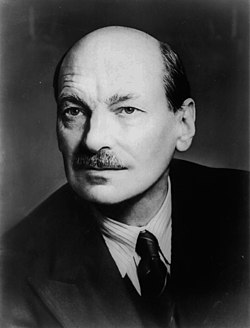5 July 1945 | |||||||||||||||||||||||||||||||||||||||||||||||||||||||||||||||||||||||||||||
All 640 seats in the House of Commons 321 seats needed for a majority | |||||||||||||||||||||||||||||||||||||||||||||||||||||||||||||||||||||||||||||
|---|---|---|---|---|---|---|---|---|---|---|---|---|---|---|---|---|---|---|---|---|---|---|---|---|---|---|---|---|---|---|---|---|---|---|---|---|---|---|---|---|---|---|---|---|---|---|---|---|---|---|---|---|---|---|---|---|---|---|---|---|---|---|---|---|---|---|---|---|---|---|---|---|---|---|---|---|---|
| Opinion polls | |||||||||||||||||||||||||||||||||||||||||||||||||||||||||||||||||||||||||||||
| Turnout | 24,073,025 72.8% ( | ||||||||||||||||||||||||||||||||||||||||||||||||||||||||||||||||||||||||||||
| |||||||||||||||||||||||||||||||||||||||||||||||||||||||||||||||||||||||||||||
 | |||||||||||||||||||||||||||||||||||||||||||||||||||||||||||||||||||||||||||||
 Composition of the House of Commons after the election | |||||||||||||||||||||||||||||||||||||||||||||||||||||||||||||||||||||||||||||
| |||||||||||||||||||||||||||||||||||||||||||||||||||||||||||||||||||||||||||||
The 1945 United Kingdom general election was held on Thursday 5 July 1945. [b] With the ongoing Second World War still fresh in the minds of voters, the opposition Labour Party led by Clement Attlee won a landslide victory with a majority of 146 seats, defeating the incumbent Conservative-led government under Prime Minister Winston Churchill. The result reflected widespread public concern about the future direction of the United Kingdom in the post-war period. [1]
Contents
- Dissolution of Parliament and campaign
- Outcome
- Reasons for Labour victory
- Results
- Votes summary
- Seats summary
- Transfers of seats
- MPs who lost their seats
- Conservative
- Liberal
- Opinion polls
- See also
- Notes
- References
- Sources
- Further reading
- External links
- Manifestos
The election's campaigning was focused on leadership of the country and its postwar future. Churchill sought to use his wartime popularity as part of his campaign to keep the Conservatives in power after a wartime coalition had been in place since 1940 with the other political parties, but he faced questions from public opinion surrounding the Conservatives' actions in the 1930s and his ability to handle domestic issues unrelated to warfare. Clement Attlee, leader of the Labour Party, had been Deputy Prime Minister in the wartime coalition in 1940–1945 and was seen as a more competent leader by voters, particularly those who feared a return to the levels of unemployment in the 1930s and who sought a strong figurehead in British politics to lead the postwar rebuilding of the country. Opinion polls when the election was called showed strong approval ratings for Churchill, but Labour had gradually gained support for months before the war's conclusion.
Labour won a landslide victory, gaining 239 seats for a total majority of 146 with 49.7% of the popular vote, allowing Attlee to become prime minister. [2] The party also won two seats in a walkover, the last time any seat in the House of Commons went uncontested in a general election. [c] This was Labour's first outright majority and enabled Attlee to begin implementing the party's post-war reforms. [3] The result was a major shock for the Conservatives, [4] who lost 189 seats despite winning 36.2% of the vote, having campaigned on the assumption that Churchill's wartime leadership would secure victory. The Liberal Party suffered a net loss of nine seats and its leader Archibald Sinclair lost his seat, while the Liberal National Party lost 22 seats, including that of its leader Ernest Brown. A total of 324 new MPs entered the House of Commons, a record that stood until 2024. [5] Additionally, the beginning of the Attlee ministry paralleled the beginning of the Truman administration in the United States.
The 11.7% swing from the Conservatives to an opposition party is the largest since the Acts of Union 1800; the Conservative loss of the vote exceeded that of the 1906 Liberal landslide ousting of a Conservative administration. It was also the first election since 1906 in which the Conservatives did not win a plurality of the popular vote. Churchill remained actively involved in politics and returned as prime minister after leading his party into the 1951 general election. For the Liberal National Party the election was their last as a distinct party, as they merged with the Conservatives in 1947 (although they operated as a subsidiary party of the Conservatives until 1968) while Ernest Brown resigned from politics in the aftermath of the election.







